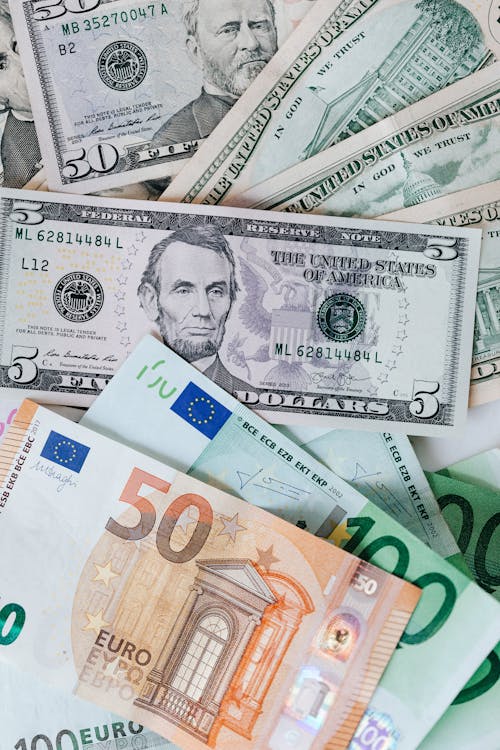Calculating Currency Exchange
To calculate currency exchange rates, financial analysts and economists consider various factors that influence the value of one currency relative to another. Exchange rates are used to determine how much one currency is worth when converted into another.
How it's calculated
- Monitor supply and demand Analysts assess the supply and demand for each currency in the foreign exchange market, as this plays a significant role in determining its value.
- Evaluate economic indicators Key indicators such as inflation, interest rates, and economic growth rates are analyzed to assess the stability and strength of a country's currency.
- Consider geopolitical factors Political stability, trade agreements, and international relations are taken into account, as they can significantly impact currency value.
- Use formulas or tools Exchange rates are calculated using tools or formulas that factor in all relevant variables. This includes using algorithms or market data provided by financial institutions and trading platforms.
Where to find currency exchange calculations
XE Currency Converter
A widely used tool that provides real-time exchange rates for currencies worldwide.
OANDA
A trusted platform offering currency conversion, historical rates, and forex trading tools.
Central Banks
Central banks, such as the European Central Bank and the Federal Reserve, publish official exchange rates and economic data that influence currency valuation.
Example
Understanding Currency Exchange Rate Calculation
Currency exchange rates determine the value of one currency when converted into another. They are essential for international trade, investment, and travel. These rates are influenced by various economic and geopolitical factors, reflecting the relative strength of currencies in the global market.
The key concepts in calculating currency exchange rates include:
- Base Currency: The currency against which other currencies are compared (e.g., USD in USD/EUR).
- Quote Currency: The currency that is being compared to the base currency (e.g., EUR in USD/EUR).
- Exchange Rate: The price of one unit of the base currency in terms of the quote currency.
- Factors Considered: Economic indicators, interest rates, inflation, political stability, and more.
Calculating Currency Exchange Rates
To calculate currency exchange rates, the following formula is typically used:
- Exchange Rate Formula: \( \text{Exchange Rate} = \frac{\text{Value of Base Currency}}{\text{Value of Quote Currency}} \)
- Exchange Rate: The amount of quote currency required to purchase one unit of the base currency.
- Value of Base Currency: The economic value of the base currency.
- Value of Quote Currency: The economic value of the quote currency.
Example: If 1 USD is equal to 0.85 EUR, the exchange rate is:
\( \text{Exchange Rate} = \frac{1}{0.85} = 1.176 \)
This indicates that 1 EUR is equivalent to approximately 1.176 USD.
Factors Affecting Currency Exchange Rates
Several factors influence exchange rate calculations:
- Interest Rates: Higher interest rates often attract foreign investments, increasing demand for the currency.
- Inflation Rates: Lower inflation typically strengthens a currency’s value compared to others.
- Political Stability: Stable governments attract investments, bolstering currency value.
- Trade Balances: Countries with a trade surplus often see their currency strengthen.
Types of Currency Exchange Rates
Exchange rates can vary depending on the context:
- Spot Rate: The current exchange rate for immediate transactions.
- Forward Rate: The agreed-upon exchange rate for transactions to be carried out at a future date.
- Fixed vs. Floating Rates: Fixed rates are pegged to another currency or commodity, while floating rates are determined by market forces.
Example: If you are trading in a floating exchange rate system and the demand for your base currency rises, its value will increase relative to other currencies.
Real-life Applications of Currency Exchange Rates
Currency exchange rates are used in various real-world scenarios:
- Facilitating international trade by determining the cost of imports and exports.
- Helping businesses manage currency risk and plan for foreign investments.
- Assisting travelers in understanding the value of their money abroad.
Common Operations in Currency Exchange Calculation
When calculating exchange rates, the following operations are common:
- Gathering market data on currency values and trends.
- Choosing a base and quote currency for the calculation.
- Using tools or formulas to compute the exchange rate.
| Calculation Type | Description | Steps to Calculate | Example |
|---|---|---|---|
| Basic Currency Conversion | Converting one currency into another using the current exchange rate. |
|
If you have $100 and the exchange rate is 1 USD = 15 ZAR, the conversion would be: \( 100 \times 15 = 1,500 \) ZAR. |
| Reverse Currency Conversion | Converting from a foreign currency back to the base currency. |
|
If you have 1,500 ZAR and the exchange rate is 1 USD = 15 ZAR, the conversion back to USD would be: \( \frac{1500}{15} = 100 \) USD. |
| Cross-Currency Conversion | Converting between two foreign currencies using an intermediary currency (e.g., USD). |
|
If converting EUR to ZAR via USD, with 1 EUR = 1.1 USD and 1 USD = 15 ZAR: \( 1 \times 1.1 = 1.1 \) USD, then \( 1.1 \times 15 = 16.5 \) ZAR. |
| Currency Exchange with Fees | Calculating the final amount after deducting exchange fees or commissions. |
|
If converting $100 to ZAR with an exchange rate of 1 USD = 15 ZAR and a 2% fee: \( 100 \times 15 = 1,500 \) ZAR, then \( 1,500 - (1,500 \times 0.02) = 1,470 \) ZAR. |
| Time-Based Currency Conversion | Calculating changes in currency value over time using historical exchange rates. |
|
If converting $100 to ZAR, with the exchange rate in 2020 as 1 USD = 14 ZAR and in 2025 as 1 USD = 16 ZAR: 2020: \( 100 \times 14 = 1,400 \) ZAR, 2025: \( 100 \times 16 = 1,600 \) ZAR. The increase is 200 ZAR. |










